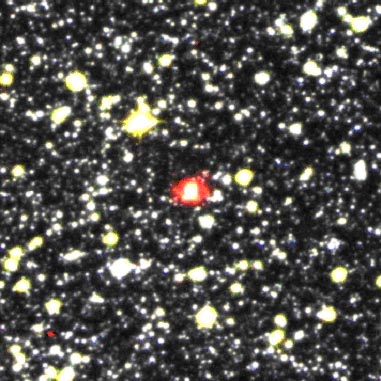 PN
G027.0+01.5 = PHR J1835-0429
PN
G027.0+01.5 = PHR J1835-0429
18 35 11.6 -04 29 06
Size 32"x25"
At 175x unfiltered a mag 13 star was visible and a small ill-defined halo
was highly suspected surrounding the star knowing the exact location.
Adding an OIII filter, the halo brightened nicely and the edge sharpened
to a 20" disc. The involved star appeared offset to the north side.
This object was originally listed in Neckel and Vehrenberg's "Atlas of Galactic Nebulae" as a "star with nebula" and then erroneously included in the 2003 "Merged Catalogue of Reflection Nebulae. The MASH catalogue is the first to identify this object as a planetary.
 PN
G014.8-08.4 = PHR J1849-1952
PN
G014.8-08.4 = PHR J1849-1952
18 49 24.3 -19 52 16
Size 19"x17"
Picked up at 300x as a very small, faint glow ~5" diameter attached
on the NW side of a mag 14.5 star with a fainter mag 15.5 star sometimes
visible on the NW edge of the glow. Adding a DGM Optics NPB filter, the
contrast increased significantly and the planetary was visible continuously
with averted vision as a ~10" disc. Surrounded by a small, partial
2' ring of mag 13-15 stars.
 PN G026.2-03.4 = PHR J1851-0732
PN G026.2-03.4 = PHR J1851-0732
18 51 31.3 -07 32 29
Size 45"x35"
As this planetary is a recent MASH discovery, I was pleasantly surprised
to find a relatively bright, fairly small disc at 175x using a NPB filter
just west of a mag 12 star (barely detached). A fainter star is just off
the NW edge. The planetary had a slightly elongated halo, ~30"-35"
in diameter, with a fairly crisp edge. Removing the filter, it was very
difficult to identify the planetary as it resides in a rich field 75'
south of M11 and the suspected haziness at the position was similar to
the general Milky Way patchiness in the field.
The following four MASH planetaries were observed by Kent Wallace using
a 20" f/5 Obsession. These are the first known visual observations
of these objects.
 PN
G010.1+07.4 = PHR J1741-1624
PN
G010.1+07.4 = PHR J1741-1624
17 41 04.0 -16 24 47
Size 12"
At 134x, 169x and 254x, faint, unsteady small disk, requiring the O-III
filter and averted vision. Fair response to the O-III and UHC filters.
No response to the H-Beta filter. This is a first known visual sighting.
 PN
G013.1+05.0 = PHR J1755-1502
PN
G013.1+05.0 = PHR J1755-1502
17 55 46.4 -15 02 44
Size 8"
At 254X, very faint, very small disk, unsteady, requiring the UHC filter
and averted vision. Fair response to the O-III and UHC filters. No response
to the H-Beta filter. The image was best through the UHC filter.
 PN
G020.9-11.3 = PHR J1911-1546
PN
G020.9-11.3 = PHR J1911-1546
19 11 04.4 -15 46 07
Size 153"
At 134X, very faint, good sized mottled disk, requiring the O-III filter
and averted vision. Fair response to the O-III and UHC filters. No response
to the H-Beta filter. Actually the UHC filter sems to be a bit better
than the O-III filter. At 169X, the image was worse.
 PN G012.1-11.2 = PPA J1855-2328 = CGMW 4-3783
PN G012.1-11.2 = PPA J1855-2328 = CGMW 4-3783
18 55 04.9 -23 28 12
Size 20"x18"
At 134X, can see it as an elongated object, perhaps a double star with
averted vision alone. Using the O-III filter with averted vision a nice
small disk envelopes the elongated object. Good response to the O-III
and UHC filters. No response to the H-Beta filter. At 169X and 254X, the
elongated object is a close double star aligned roughly NE-SW with the
brighter component to the SW. Again, the use of the O-III filter with
averted vision envelopes the double.